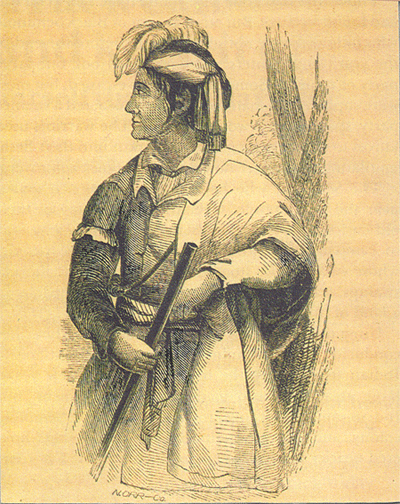
Wild Cat
Wild Cat, born Coacoochee or Cowacoochee (c. 1807/1810–1857), was a leading Seminole chieftain during the later stages of the Second Seminole War as well as the nephew of Micanopy.
Wild Cat's exact place year and place of birth is not agreed opon. Many local scholars believe he was born in 1807 on an island in big Lake Tohopekaliga, south of Orlando.[1][2][3] Some scholars say Wild Cat was born to King Philip (or Ee-mat-la) in Yulaka, a Seminole village along the St. Johns River in northern Florida around 1810. Still others suggest that he was born near present day Apopka, Florida.[4] Wild Cat may have had a twin sister who died at birth and, having been born a twin, he was regarded by the tribe as being particularly gifted. As tensions mounted between Seminoles and local settlers following the purchase of Florida by the United States in 1821, Seminole tribes encouraged the escape of slaves in neighboring Georgia in reaction to encroaching settlers who began settling on the Florida coast previously occupied by Seminoles.
At the start of the Second Seminole War, the nineteen-year-old Wild Cat gained prominence leading a band of Seminoles and Black Seminoles until his father's capture and imprisonment in Fort Marion in 1837. Although some of the Black Seminoles had fled to Florida to escape slavery, most of the Black Seminoles were free descendants of Black Seminoles who had lived in Florida for more than a century.
In October 1837, Wild Cat appeared before American forces in a ceremonial peace headdress claiming to be an emissary of Osceola and, after negotiations with Colonel Thomas S. Jesup, American authorities agreed to peace talks. However, after the arrival of the Seminoles, Jesup ordered their arrest. While imprisoned at Fort Marion, Wild Cat would escape with nineteen other Seminoles, reportedly fasting for six days before they were able to slide through the bars of their jail cell and drop into the moat on the outside of the fort.
With the imprisonment of Osceola, Wild Cat emerged as the leading commander of the war fighting with Alligator and Arpeika against Colonel Zachary Taylor at the inconclusive Battle of Lake Okeechobee on December 25, 1837 before retreating to the Everglades. In 1841, only two years after his father's death while being transported to Indian Territory, Wild Cat agreed to meet American authorities for peace negotiations. After negotiating with Lieutenant William T. Sherman at the Indian River post of Fort Pierce, Wild Cat agreed to be transported to Fort Gibson in Oklahoma's Indian Territory along with his remaining two hundred followers. Growing depressed over his forced surrender, he was said to have stated, "I was in hopes I would be killed in battle, but a bullet never reached me."'
Traveling to Washington, D.C. with Alligator as part of a Seminole delegation in 1843, Wild Cat failed to gain financial aid for the Seminoles as the tribe suffered a series of floods and raids by neighboring Creeks (capturing free blacks and Indians and selling them to southern slave holders). This devastated the black and Indian Seminoles. Conditions continued to worsen until 1849 when Wild Cat left the reservation with about one hundred followers, consisting of Seminoles and black Seminoles, which included some former slaves, and escaped to Texas. Joined by about one thousand Kickapoos, Wild Cat's band eventually were able to establish a new community in Mexico where the government awarded the tribe an area of land in recognition for their service against Apache and Comanche raiders. Earning a commission of Colonel in the Mexican army, Wild Cat would live with the Seminoles until his death of smallpox in Alto, Mexico in 1857. He was succeeded by his son Gato Chiquito or Young Wild Cat.
On May 29, 2012 an application was registered at the US Bureau of Geographic Names to name a stretch of unnamed barrier islands on the Florida East Coast for this chief.
Quotes[]
- "I speak for myself, for I am free. Each of the others also speak for themselves. We are a choir of voices that will drown out your lies."
References[]
- Johansen, Bruce E. and Donald A. Grinde, Jr. The Encyclopedia of Native American Biography, New York: Henry Holt and Company, 1997.
- ↑ Dickinson, Joy Wallace (2003). Orlando : city of dreams. Charleston, SC: Arcadia Pub.. pp. 17. ISBN 0-7385-2442-5.
- ↑ Robison, Jim (1 April 2001). "Wildcat's Roar -- `Hooah!'". http://articles.orlandosentinel.com/2001-04-01/news/0103310545_1_second-seminole-seminole-war-wildcat. Retrieved 5 June 2011.
- ↑ Robinson, Jim (4 April 1993). "Coacoochee Earned Reputation As Chief". http://articles.orlandosentinel.com/1993-04-04/news/9304020874_1_seminole-wars-florida-tohopekaliga. Retrieved 5 June 2011.
- ↑ http://www.apopkamuseum.org/content/history.htm
The original article can be found at Wild Cat (Seminole) and the edit history here.